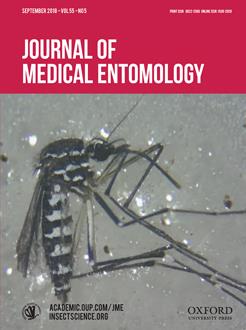Haematobia irritans (L.) (Diptera: Muscidae) were netted from pastured cattle in California over two summers, with the goal of documenting on-host sex ratios and mating success as they might vary with repellent applications. Sex ratios were calculated from 100 adults per herd per date, and mating status of females (n = 30 per herd per date) was assessed by dissection of spermathecae. Flies were collected before, during, and after 2-wk treatment periods with each of two repellent-oil mixtures: a 15% mixture of fatty acids (C8, C9, C10) in mineral oil or a 2% solution of geraniol in mineral oil. During the treatment period, flies were collected 3–4 d after the prior treatment and immediately before the next treatment. A separate herd used in the second year was untreated. Overall, the proportion female was 0.65 ± 0.01 (mean ± SE) (range 0.28–0.81). Sex ratios were not altered over time by treatments with either repellent. Overall, proportion of females mated was 0.744 ± 0.018 (range 0.40–1.00). Mating status was significantly affected by the two repellent treatments, which did not differ from each other. For treatment herds, proportion mated before treatment was 0.789 ± 0.039, dropping significantly to 0.659 ± 0.038 during the treatment period, and rebounding to 0.750 ± 0.035 after treatments ceased. Treatments probably killed or repelled the existing heterogeneous fly population, and during treatment relatively more flies were unmated recent arrivals.
How to translate text using browser tools
25 April 2018
Sex Ratios and Mating Status of the Horn Fly on Pastured Cattle as a Function of Repellent-Oil Treatments
Bradley A. Mullens,
Diane Soto,
Alec C. Gerry
ACCESS THE FULL ARTICLE
It is not available for individual sale.
This article is only available to subscribers.
It is not available for individual sale.
It is not available for individual sale.

Journal of Medical Entomology
Vol. 55 • No. 5
September 2018
Vol. 55 • No. 5
September 2018
Diptera
fatty acid
geraniol
Haematobia irritans
mating




